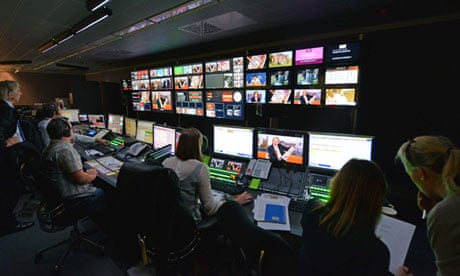It is the BBC's most expensive development: the £1bn double-atrium newsroom, tucked away behind All Souls church at the north end of Regent Street in London, which by next March will house 6,000 staff over 11 floors.
The 93,000 square metre development may be just over four years late, and £55m over budget after a falling out with its original architect – but the replacement for the familiar Television Centre is finally coming on air.
Last Sunday, the New Broadcasting House, behind the famous art deco headquarters used by Lord Reith, broadcast its first network programme – The Andrew Marr Show – with a string of national TV and radio shows due to move between now and Christmas.
Newsnight will follow Marr into the basement in October, with Jeremy Paxman already visiting for rehearsals. The programmes will share one of five studios below ground level, carefully constructed with internal and external brickwork separated by a layer of air to reduce noise and movement from outside.
Today and other Radio 4 news programmes are due to arrive by the end of the year, on the third floor, a level below the office reserved for incoming director general George Entwistle, whose predecessor but one had to resign after a row about the contents of the early morning radio programme.
Meanwhile Huw Edwards and the One, Six, and Ten O'Clock news bulletins are due to arrive in the first three months of next year, although a camera is already perched on a miniature railway which will sweep from the news studio to the weather centre yards away.
One of the studios is a so-called "virtual reality" set, in effect little more than a green background, chairs and a table, on to which logos, graphics and images can be superimposed. It is the first time BBC News has used such a set, which it hopes will create the illusion of greater visual variety for viewers.
Andy Griffee, the BBC's project leader for the past three and a half years, says that the goal was to bring as much of the BBC as possible "under one roof" in the building, eventually finished by architects Sheppard Robson. Such is the bureaucracy of the BBC that Griffee says it is possible to save £5m a year in technical support just by bringing so many employees together.
But while it has proved possible to squeeze Radio 1 into the best location, the uppermost eighth floor, some London parts of the corporation are left out.
Radio 2 will remain in its current building just up the road, and the television commissioners behind the likes of Strictly Come Dancing are stuck in White City – but most of the rest has been crammed in, including World Service staff, who moved over from the warren of Bush House in the summer.
Some of the building has been designed to maximise collaboration and casual encounters between staff, including "helical staircases" – without a central pole – which run into the newsroom and are intended to be an alternative to the isolation of the 15 lifts that collectively run for half a mile.
But a third set of architects, HOK, was brought in to complete the fit-out of the building – and found it necessary to ensure there were private areas where people could take "contentious phone calls" and hold team meetings, according to an associate at that firm, Dan Herriott.
Once the site is up and running, the public will be allowed to use the BBC cafe on Portland Place, which has a view of the main open-plan newsroom one level below ground. Although the building's designers remain coy about details, they insist that it will not be possible for protesters or even terrorists to break through the glass that separates the newsroom from the cafe above.
Architects said that one of the most complex features of the New Broadcasting House project was contending with the rattle of the underground lines below – Lucy Homer from Sheppard Robson said the building sat on "blocks of stainless steel industrial springs" to dampen the vibration from the Bakerloo and Victoria lines.
Even so, to fit everything in, Homer said that part of the building encroached slightly on the 6 metre "exclusion zone" above any London Underground line. Tests had to be conducted with London Underground to ensure that the foundations, which came no more than 1 metre into the exclusion zone, had no impact on the Victoria Line northbound.
Sheppard Robson was brought in halfway through the project to replace Sir Richard MacCormac – forced off the project in 2005 after a row over design and cost – amid complaints that he had been treated with "insufferable contempt" by outgoing director general Mark Thompson. The curved glass "cyclorama" on the outside of the building, which wraps around John Nash's Grade 1 listed All Souls church, is from the original design, which includes glass shaded to match the grey Portland stone of the original 1930s building.
However, plans for a complex fluted columns rising up from the newsroom were dropped in favour of a more functional design aimed at fitting more staff in. Homer said that the old design was somewhat darker and that by having two atriums between the office floors above, "daylight was much improved" in a way that would ensure the BBC has a happy experience of the site.
Nevertheless, while it will be easier to bring high profile guests to central London as compared to White City, other benefits of the £1bn spend are more subtle. Barney Jones, the editor of Andrew Marr's programme, says that one advantage of the new studio is that the gesticulating journalist can now always introduce his Sunday morning programme whilst walking in, whereas previously smaller quarters in West London meant there was a risk of him tripping over parts of the set prepared for the musicians who round off his programme.
